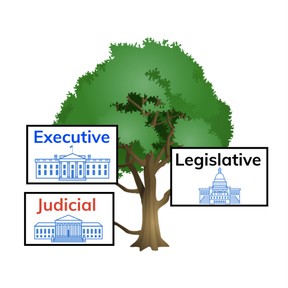
Explain the 3 Branches of Government
I can identify the 3 branches of government and explain their purposes.



8,000 schools use Gynzy
92,000 teachers use Gynzy
1,600,000 students use Gynzy
General
This lesson teaches students about the structure of the United States government and how it is broken down into three branches: the legislative, executive, and judicial. Students will learn about the functions of each of these branches of government and how they check or balance the power of the other branches to ensure that power is evenly distributed throughout the government. Throughout the lesson, have students consider the question of why it is important that power remains evenly distributed throughout the government, rather than accruing too much in any one branch.
Learning Objective
Students will be able to explain the responsibilities of the legislative, executive, and judicial branches and explain how they work together to help our government run smoothly.
Introduction
Students begin by discussing the different adults who work in their school. What are their jobs? What do they do each day? Who do they work with? Why are each of these people important to the function of the school? From here, explain that all of these people work together to make the school successful. The U.S. government works the same way and is divided into 3 branches of government: executive, legislative, and judicial. The three branches are necessary because they keep each other in check and prevent others from having too much power.
Instruction
Begin with the legislative branch which is responsible for making our laws. The legislative branch, or Congress, is divided into 2 parts: the Senate and the House of Representatives. Give students some more information about each of these, beginning with the Senate. Then, go over the House of Representatives. Have students visit the government website linked in the lesson and find out how many representatives are in their state. Use the pencil tool to write the correct letter for either the Senate or the House of Representatives. Next, explain the responsibilities of the executive branch. Go over the president’s cabinet and the importance of the different departments in the branch. Discuss presidential elections and ask students why they think a president cannot serve more than 2 terms. What do they think of the requirement for presidential candidates? Students then drag words to complete sentences. Finally, discuss the judicial branch and the Supreme Court. Test students’ knowledge by having them drag words into correct boxes.
Quiz
Check student understanding with ten multiple-choice and fill-in questions in which they must answer questions about each of the 3 branches.
Closing
Ask students why it’s important to learn about our government. Then have them list everything they can about each of the three branches. In the end, see what they came up with. Try not to let students repeat what others have already written.
Related lessons
It is important for students to understand the basic structure of our government so that they can be informed about how our government works and why it was set up the way it was. Here are some lessons which can be paired with this one to give students a more complete understanding of the US government:
- The Purpose of the Constitution
- The Purpose of the Bill of Rights
- The local, state, and national level of the US government
- How a bill becomes a law
- How the government uses taxes
The online teaching platform for interactive whiteboards and displays in schools
Save time building lessons
Manage the classroom more efficiently
Increase student engagement
Discover more!
About Gynzy
Gynzy is an online teaching platform for interactive whiteboards and displays in schools.
With a focus on elementary education, Gynzy’s Whiteboard, digital tools, and activities make it easy for teachers to save time building lessons, increase student engagement, and make classroom management more efficient.



